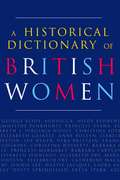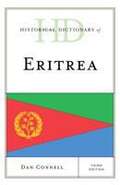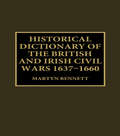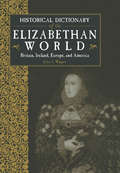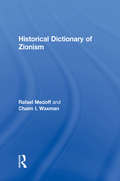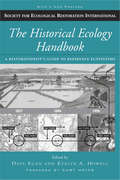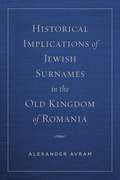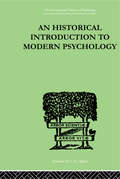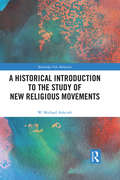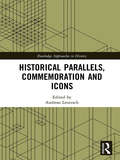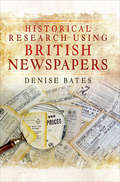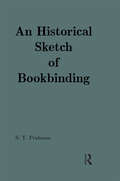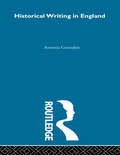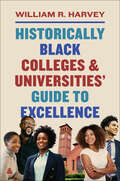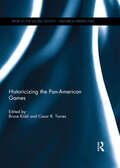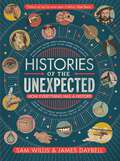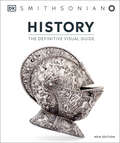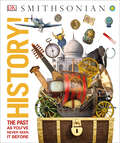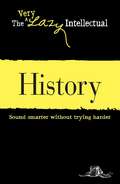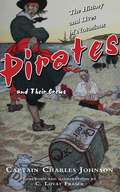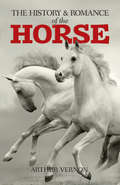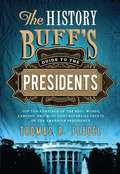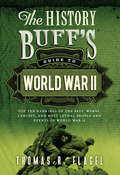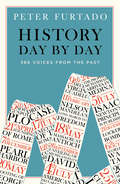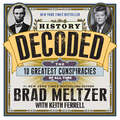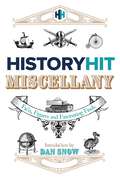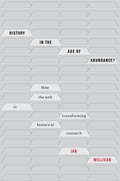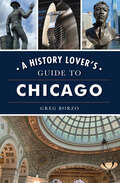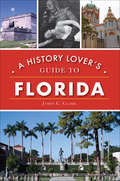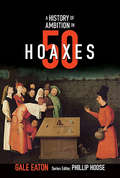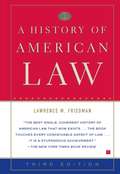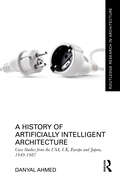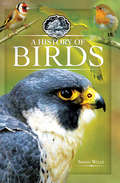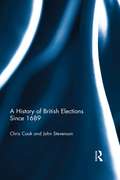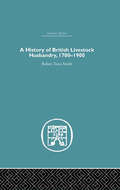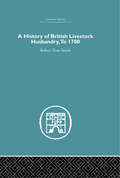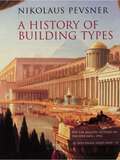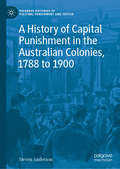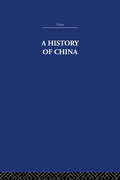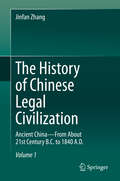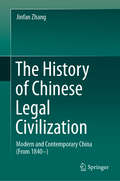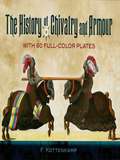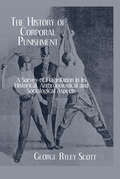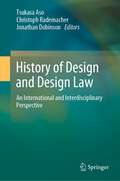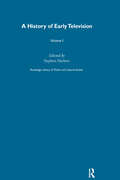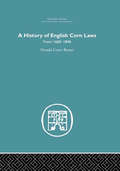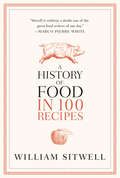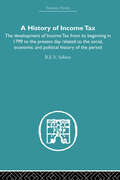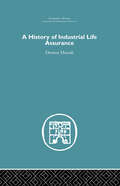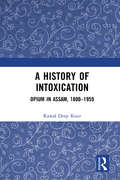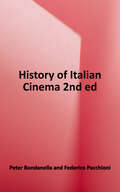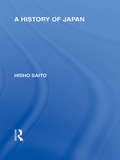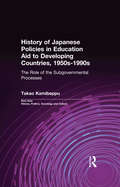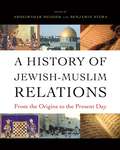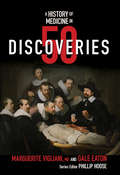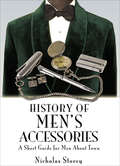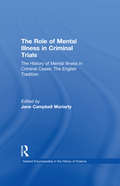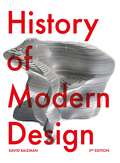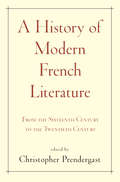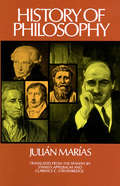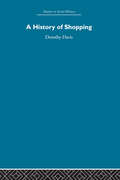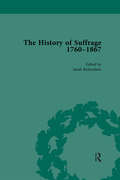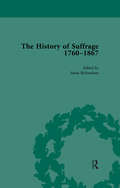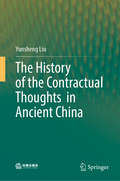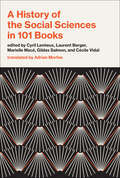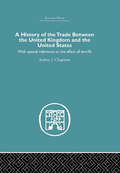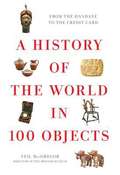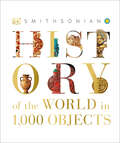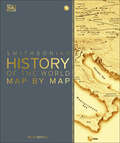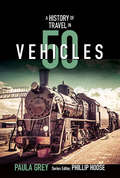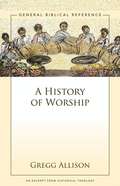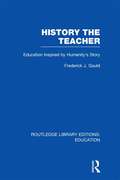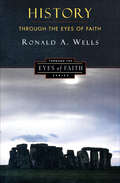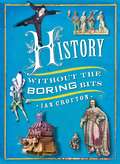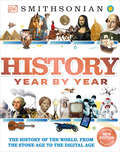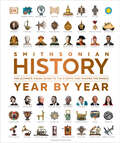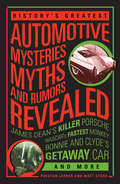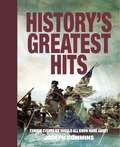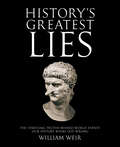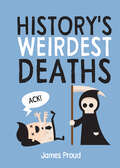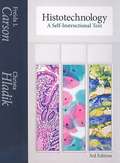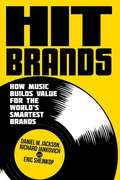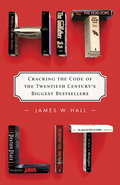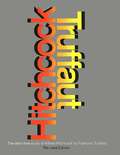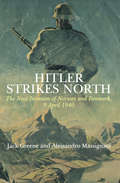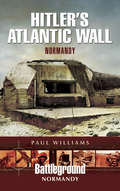- Table View
- List View
The Historical Books
by L. Thomas HoldcroftIt deals with the twelve books of the Bible from Joshua through Esther, and is intended as a textbook, a commentary, a reference source, or a study manual.
A Historical Dictionary of British Women
by Cathy HartleyThis reference book, containing the biographies of more than 1,100 notable British women from Boudicca to Barbara Castle, is an absorbing record of female achievement spanning some 2,000 years of British life.Most of the lives included are those of women whose work took them in some way before the public and who therefore played a direct and important role in broadening the horizons of women. Also included are women who influenced events in a more indirect way: the wives of kings and politicians, mistresses, ladies in waiting and society hostesses.Originally published as The Europa Biographical Dictionary of British Women, this newly re-worked edition includes key figures who have died in the last 20 years, such as The Queen Mother, Baroness Ryder of Warsaw, Elizabeth Jennings and Christina Foyle.
Historical Dictionary of Eritrea (Historical Dictionaries of Africa)
by Dan ConnellIn 1991, Eritrea, a country in northeast Africa, won a 30-year war for independence from Ethiopia, and in 1993 it was recognized as Africa's newest nation after more than a century of conquest and occupation by a succession of external powers that included the Ottomans, Egypt, Italy, Great Britain, and Ethiopia. Each left its mark while fostering a deep distrust of outsiders and a fierce commitment to Eritrea's separate political identity. Eritrea and Ethiopia slipped into a chronic state of no-peace-no-war that kept the entire Horn of Africa off balance for nearly two decades. The standoff ended in 2018 when a newly installed Ethiopian prime minister reached out to Eritrea and set in motion a rapid-fire series of talks among the states of the African Horn that broke down long-standing barriers and raised hopes for a new era of regional peace and cooperation. This third edition of Historical Dictionary of Eritrea contains a chronology, an introduction, appendixes, an extensive bibliography, and more than 600 cross-referenced entries on important personalities and aspects of the country's politics, economy, foreign relations, religion, and culture. This book is an excellent resource for students, researchers, and anyone wanting to know more about Eritrea. DAN CONNELL is a visiting scholar at Boston University's African Studies Center and a retired senior lecturer in journalism and African politics at Simmons College, Boston. He has also consulted for numerous development agencies and human rights organizations and is the founder and former director of Grassroots International. He is working on a book about the experiences of Eritrean refugees. The DAISY markup is as follows: Letters of the alphabet are at level 1; individual entries are at level 2.
Historical Dictionary of the British and Irish Civil Wars, 1637-1660 (Historical Dictionaries Of War, Revolution, And Civil Unrest Ser. #No. 14)
by Martyn BennettDuring the 17th century the British Isles were trapped in a 23-year-long state of turmoil through civil war, continued rebellion, and revolutions. King Charles I wanted to instill a new uniform religious policy throughout the British Isles, and this caused a massive uproar over the King's policies toward the diverse people in his kingdom, the English, Irish, Scottish, and Welsh. Through a concise historical chronology and comprehensive overview, users of the Historical Dictionary of the British and Irish Civil Wars will find a very insightful explanation of the people, places, and events that indelibly shaped the United Kingdom's 17th-century history. The cross-listed dictionary entries offer a complete explanation of each important aspect of the Civil Wars and their effect on the kingdom. Also includes maps and a bibliography.
Historical Dictionary of the Elizabethan World: Britain, Ireland, Europe and America
by John A. WagnerNo period of British history generates such deep interest as the reign of Elizabeth I, from 1558 to 1603. The individuals and events of that era continue to be popular topics for contemporary literature and film, and Elizabethan drama, poetry, and music are studied and enjoyed everywhere by students, scholars, and the general public.The Historical Dictionary of the Elizabeth World provides clear definitions and descriptions of people, events, institutions, ideas, and terminology relating in some significant way to the Elizabethan period. The first dictionary of history to focus exclusively on the reign of Elizabeth I, the Dictionary is also the first to take a broad trans-Atlantic approach to the period by including relevant individuals and terms from Irish, Scottish, Welsh, American, and Western European history.Editors' Choice: Reference
Historical Dictionary of Zionism (Religions, Philosophies, And Movements Ser. #No. 31)
by Chaim I. Waxman Rafael MedoffThe Jewish attachment to Zion is many centuries old. Although the modern Zionist movement was organized only a little more than a century ago, the roots of the Zionist idea reach back almost 4,000 years, to the day that the biblical patriarch Abraham left his home in Ur of the Chaldees to settle in the promised land The Historical Dictionary of Zionism is an excellent source of information on Zionism, its founders and leaders, its various strands and organizations, major events in its struggle, and its present status. By showing the movement's strengths and weaknesses, it also acts as a corrective to overly idealistic comments by its supporters and the wilder claims of its opponents. A much more realistic understanding is offered in the Introduction, which presents and explains the movement; the Chronology, which shows its historic progression; the Dictionary, which includes numerous entries on crucial persons, organizations and events; and the Bibliography, which points the way to further reading.
The Historical Ecology Handbook: A Restorationist's Guide to Reference Ecosystems (Science Practice Ecological Restoration)
by Dave Egan Curt Meine Evelyn A. HowellThe Historical Ecology Handbook makes essential connections between past and future ecosystems, bringing together leading experts to offer a much-needed introduction to the field of historical ecology and its practical application by on-the-ground restorationists.Chapters present individual techniques focusing on both culturally derived evidence and biological records, with each chapter offering essential background, tools, and resources needed for using the technique in a restoration effort. The book ends with four in-depth case studies that demonstrate how various combinations of techniques have been used in restoration projects.The Historical Ecology Handbook is a unique and groundbreaking guide to determining historic reference conditions of a landscape. It offers an invaluable compendium of tools and techniques, and will be essential reading for anyone working in the field of ecological restoration.
The Historical Formation of the Arab Nation: A Study In Identity And Consciousness (Routledge Library Editions: The Arab Nation)
by A A DuriThis book is a comprehensive examination of the historical process of social formation that gave rise to the communal consciousness of the Arab nation and determined its sense of identity. It aims to provide a historical context for the assessment of prevailing concepts and suggests hypotheses for the development of modern Arab consciousness. The book firstly traces Arab origins and the formation of Arab societies after the emergence of Islam, assessing the perspectives and factors that shaped the rise of the Arab nation in both practical and intellectual terms. It then examines the beginning of the Arab awakening and the course of its development in the latter half of the nineteenth century and the first two decades of the twentieth, focusing on the emergence of a nationalist perspective in the development of intellectual positions on patriotism and Arabism.
Historical Implications of Jewish Surnames in the Old Kingdom of Romania (The Joseph and Rebecca Meyerhoff Center for Jewish Studies: Studies and Texts in Jewish History and Culture)
by Alexander AvramLinguistic and semantic features in names—and surnames in particular—reveal evidence of historical phenomena, such as migrations, occupational structure, and acculturation. In this book, Alexander Avram assembles and analyzes a corpus of more than 28,000 surnames, including phonetic and graphic variants, used by Jews in Romanian-speaking lands from the sixteenth century until 1944, the end of World War II in Romania.Mining published and unpublished sources, including Holocaust-period material in the Yad Vashem Archives and the Pages of Testimony collection, Avram makes the case that through a careful analysis of the surnames used by Jews in the Old Kingdom of Romania, we can better understand and corroborate different sociohistorical trends and even help resolve disputed historical and historiographical issues. Using onomastic methodology to substantiate and complement historical research, Avram examines the historical development of these surnames, their geographic patterns, and the ways in which they reflect Romanian Jews’ interactions with their surroundings. The resulting surnames dictionary brings to light a lesser-known chapter of Jewish onomastics. It documents and preserves local naming patterns and specific surnames, many of which disappeared in the Holocaust along with their bearers.Historical Implications of Jewish Surnames in the Old Kingdom of Romania is the third volume in a series that includes Pleasant Are Their Names: Jewish Names in the Sephardi Diaspora and The Names of Yemenite Jewry: A Social and Cultural History, both of which are available from Penn State University Press. This installment will be especially welcomed by scholars working in Holocaust studies.
Historical Implications of Jewish Surnames in the Old Kingdom of Romania
by Alexander AvramLinguistic and semantic features in names—and surnames in particular—reveal evidence of historical phenomena, such as migrations, occupational structure, and acculturation. In this book, Alexander Avram assembles and analyzes a corpus of more than 28,000 surnames, including phonetic and graphic variants, used by Jews in Romanian-speaking lands from the sixteenth century until 1944, the end of World War II in Romania.Mining published and unpublished sources, including Holocaust-period material in the Yad Vashem Archives and the Pages of Testimony collection, Avram makes the case that through a careful analysis of the surnames used by Jews in the Old Kingdom of Romania, we can better understand and corroborate different sociohistorical trends and even help resolve disputed historical and historiographical issues. Using onomastic methodology to substantiate and complement historical research, Avram examines the historical development of these surnames, their geographic patterns, and the ways in which they reflect Romanian Jews’ interactions with their surroundings. The resulting surnames dictionary brings to light a lesser-known chapter of Jewish onomastics. It documents and preserves local naming patterns and specific surnames, many of which disappeared in the Holocaust along with their bearers.Historical Implications of Jewish Surnames in the Old Kingdom of Romania is the third volume in a series that includes Pleasant Are Their Names: Jewish Names in the Sephardi Diaspora and The Names of Yemenite Jewry: A Social and Cultural History, both of which are available from Penn State University Press. This installment will be especially welcomed by scholars working in Holocaust studies.
An Historical Introduction To Modern Psychology (International Library Of Psychology Ser.)
by Murphy, GardnerFirst published in 1999. Routledge is an imprint of Taylor & Francis, an informa company.
A Historical Introduction to the Study of New Religious Movements (Routledge New Religions)
by W. Michael AshcraftThe American public’s perception of New Religious Movements (NRMs) as fundamentally harmful cults stems from the "anticult" movement of the 1970s, which gave a sometimes hysterical and often distorted image of NRMs to the media. At the same time, academics pioneered a new field, studying these same NRMs from sociological and historical perspectives. They offered an interpretation that ran counter to that of the anticult movement. For these scholars in the new field of NRM studies, NRMs were legitimate religions deserving of those freedoms granted to established religions. Those scholars in NRM studies continued to evolve methods and theories to study NRMs. This book tells their story. Each chapter begins with a biography of a key person involved in studying NRMs. The narrative unfolds chronologically, beginning with late nineteenth- and early-twentieth century perceptions of religions alternative to the mainstream. Then the focus shifts to those early efforts, in the 1960s and 1970s, to comprehend the growing phenomena of cults or NRMs using the tools of academic disciplines. The book’s midpoint is a chapter that looks closely at the scholarship of the anticult movement, and from there moves forward in time to the present, highlighting themes in the study of NRMs like violence, gender, and reflexive ethnography. No other book has used the scholars of NRMs as the focus for a study in this way. The material in this volume is, therefore, a fascinating viewpoint from which to explore the origins of this vibrant academic community, as well as analyse the practice of Religious Studies more generally.
Historical Parallels, Commemoration and Icons (Routledge Approaches to History)
by Andreas LeutzschHistorical parallels, analogies, anachronisms and metaphors to the past play a crucial role in political speeches, historical narratives, iconography, movies and newspapers on a daily basis. They frame, articulate and represent a specific understanding of history and can be used not only to construct but also to rethink historical continuity. Almost-forgotten or sleeping history can be revived to legitimize an imagined future in a political discourse today. History can hardly be neutral or factual because it depends on the historian’s, as well the people’s, perspective as to what kind of events and sources they combine to make history meaningful. Analysing historical analogies – as embedded in narratives and images of the past – enables us to understand how history and collective memory are managed and used for political purposes and to provide social orientation in time and space. To rethink theories of history, iconology and collective memory, the authors of this volume discuss a variety of cases from Hong Kong, China and Europe.
Historical Research Using British Newspapers
by Denise BatesThanks to digitisation, newspapers from the seventeenth to the twenty-first century have become an indispensable and accessible source for researchers. Through their pages, historians with a passion for a person or a place or a time or a topic can rediscover forgotten details and gain new insights into the society and values of bygone ages.Historical Research Using British Newspapers provides plenty of practical advice for anyone intending to use old newspapers by: * outlining the strengths of newspapers as source material * revealing the drawbacks of newspapers as sources and giving ways to guard against them * tracing the development of the British newspaper industry * showing the type of information that can be found in newspapers and how it can be used * identifying the best newspapers to start with when researching a particular topic * suggesting methods to locate the most relevant articles available * demonstrating techniques for collating, analysing and interpreting information * showing how to place newspaper reports in their wider contextIn addition nine case studies are included, showing how researchers have already made productive use of newspapers to gain insights that were not available from elsewhere.
An Historical Sketch of Bookbinding
by Sarah T. PrideauxAn Historical Sketch Of Bookbinding is a part of ‘The History of Bookbinding Technique and Design’-A series of reprint volumes, original monographs, and translations relating to the history of bookbinding. The chief part of the present book was written as an Introduction to the Catalogue of the Exhibition of Bindings, held at the Burlington Fine Arts Club in the Summer of 1891. Includes an appendix of a detailed account of embroidered covers, metal ornaments and book-edge decoration from the ‘Magazine of Art.’
Historical Writing in England: 550 - 1307 and 1307 to the Early Sixteenth Century
by Antonia GransdenUsing a variety of sources including chronicles, annals, secular and sacred biographies and monographs on local histories Historical Writing in England by Antonia Gransden offers a comprehensive critical survey of historical writing in England from the mid-sixth century to the early sixteenth century. Based on the study of the sources themselves, these volumes also offer a critical assessment of secondary sources and historiographical development.
Historical Writing in England: 550 - 1307 and 1307 to the Early Sixteenth Century
by Antonia GransdenUsing a variety of sources including chronicles, annals, secular and sacred biographies and monographs on local histories Historical Writing in England by Antonia Gransden offers a comprehensive critical survey of historical writing in England from the mid-sixth century to the early sixteenth century. Based on the study of the sources themselves, these volumes also offer a critical assessment of secondary sources and historiographical development.
Historically Black Colleges and Universities' Guide to Excellence
by Dr. William R. HarveyFrom the esteemed President of Hampton University, an insider account that reveals the secret to HBCU graduates’ remarkable success—a distinguished honor roll which includes Vice President Kamala Harris, Dr. Martin Luther King Jr., Oprah Winfrey, Zora Neale Hurston, Toni Morrison, Ruth Carter, Ta-Nehisi Coates, and many others.In his more-than-four-decade tenure as the President of Hampton University—one of 107 Historically Black Colleges and Universities in America—Dr. William R. Harvey has been a champion of the cultural impact and value of HBCUs, demonstrated by the achievements of their numerous notable alumni. Their success is no coincidence. It is the result of a faultless formula that sets HBCUs apart and helps their students thrive—a formula built on core tenets, including displaying moral and wholesome values at all times, continuously pursuing character growth, and embracing communal responsibilities whenever possible.The mission of Dr. Harvey is to represent Blackness to its highest degree at every opportunity. He is a passionate believer in the remarkability of the Black diaspora in all its complexity and beauty. That conviction drives the timeless lessons he’s adhered to and has instilled in his students: the power of dress to establish respect; the importance of integrity; financial accountability; reverence for elders. It is these tried-and-true lessons and others that have uniquely prepared and propelled HBCU students to success for generations. The Historically Black Colleges and Universities' Guide to Excellence is a thoughtful and knowledgeable account of what it truly takes to successfully navigate a white world as a Black person while retaining one’s core Blackness. Practical and proven, it lays the groundwork for individual and communal Black prosperity.
Historicizing the Pan-American Games (Sport in the Global Society - Historical Perspectives)
by Bruce Kidd and Cesar R. TorresThe Pan-American Games, begun officially in 1951 in Buenos Aires and held in every region of the western hemisphere, have become one of the largest multi-sport games in the world. 6,132 athletes from 41 countries competed in 48 sports in the 2015 Games in Toronto, Canada. The Games are simultaneously an avenue for the spread of the Olympic Movement across the Americas, a stage for competing ideologies of Pan-American unity, and an occasion for host city infrastructural stimulus and economic development. And yet until this volume, the Games have never been studied as a single entity from a scholarly viewpoint. Historicizing the Pan-American Games presents 12 original articles on the Games. Topics range from the origins of the Games in the period between the world wars, to their urban, hemispheric and cultural legacies, to the policy implications of specific Games for international sport. The entire collection is set against the shifting economic, social, political, cultural, sporting and artistic contexts of the turbulent western hemisphere. Historicizing the Pan-American Games makes a significant contribution to the literature on major games, Olympic sport and sport in the western hemisphere. This book was previously published as a special issue of The International Journal of the History of Sport.
Histories of the Unexpected: How Everything Has a History (Histories Of The Unexpected Ser.)
by James Daybell Sam Willis'History as you've never seen it before.' Dan Snow'A wonderful, eclectic and entertaining history of everything, full of fascinating, surprising stories.' Suzannah LipscombDid you know that the history of the beard is connected to the Crimean War; that the history of paperclips is all about the Stasi; and that the history of bubbles is all about the French Revolution? And who knew that Heinrich Himmler, Tutankhamun and the history of needlework are linked to napalm and Victorian orphans?In Histories of the Unexpected, Sam Willis and James Daybell lead us on a journey of discovery that tackles some of the greatest historical themes - from the Tudors to the Second World War, from the Roman Empire to the Victorians - but via entirely unexpected subjects.By taking this revolutionary approach, they not only present a new way of thinking about the past, but also reveal the everyday world around us as never before.
History: The Definitive Visual Guide (DK Definitive Visual Encyclopedias)
by DKThis lavishly illustrated visual encyclopedia tells the story of our world in depth and detail from the dawn of civilization to the present day.Charting human endeavor from every angle, SI History chronicles the significant events, ground-breaking ideas, political forces, and technological advances that have shaped our planet. Every historical episode is explored and explained with the help of stunning images that bring the authoritative text to life. Important points in history, from the battle of Hastings and the storming of the Bastille to D-Day and 9/11, have clear but concise coverage, together with profiles of influential figures, such as Julius Caesar, Cleopatra, and Nelson Mandela. It&’s time to head back in time and explore the past with this striking history book, which features: - Profiles of key people who have made history.- Features on inventions, discoveries, and ideas that changed the world.- Graphics lend immediacy and impact to key statistics.- National Histories section separately chronicles key events of every countryAs each moment in history is defined and detailed, supporting panels note the causes and consequences, providing wider context and broadening our horizons. New and enhanced coverage of recent events – such as the Arab Spring – and contemporary issues such as climate change and the COVID-19 pandemic, bring the book firmly into the present. With its broad-themed approach to important historical events, this book shows that ours is a history with genes and viruses, not just battle and treaties – and the stories and biographies of men and women from every corner of the globe who have shaped today&’s world reaffirm that SI History is the story of humankind in which everyone has a part to play.
History!: The Past as You've Never Seen it Before (DK Knowledge Encyclopedias)
by DKJourney back in time and marvel at the history of our world like never before with this children's encyclopedia perfect for curious kids. Forming part of a fantastic series of kid's educational books, this bold and brilliant kid's encyclopedia uses ground-breaking CGI imagery to reveal the world as you've never seen it before. Informative, diverse in subject matter, easy-to-read and brimming with beautiful graphics, young learners can explore the incredibly detailed cross-sections and cutaways that reveal the inner workings of just about everything! This charming children&’s encyclopedia opens the world in new ways, with: - Packed with facts, charts, timelines, and infographics that cover a vast range of topics.- Encompassing a visual approach with illustrations, photographs and extremely detailed 3D CGI images.- Crystal clear text distills the key information.- DK's encyclopedias are fact-checked by subject experts to offer accuracy beyond online sources of information.This fully-updated edition of Knowledge Encyclopedia History! is the perfect encyclopedia for children aged 9-12, ideal for inquisitive minds, bringing key moments in history to life, from exploring the lives of early humans to visiting the Vikings, learning about The Industrial Revolution, and looking towards a greener future! Jam-packed with fun facts about the world, including fascinating statistics, maps, timelines, graphics, and superb photorealistic cross-sections, young history lovers can peer inside ancient buildings, marvel at elaborate outfits, and get close to the battles of history!Explore, Discover And Learn!DK's Knowledge Encyclopedia History! uncovers the marvels of our world in unprecedented detail and with stunning realism. Encompassing engaging historical facts about our world, you can spend quality time diving into the past with your children, accompanied by impressive visuals to engage their senses. A must-have volume for curious kids with a thirst for knowledge, this enthralling children&’s encyclopedia is structured in such a way that your child can read a bit at a time, and feel comfortable to pause and ask questions. Doubling up as the perfect gift for young readers, who are always asking questions about our planet! At DK, we believe in the power of discovery. This thrilling kid&’s encyclopedia is part of the Knowledge Encyclopedia educational series. Celebrate your child&’s curiosity as they complete the collection and discover diverse facts about the world around them. Dive into the deep blue with Knowledge Encyclopedia Ocean! Travel back in time to when dinosaurs roamed the earth with Knowledge Encyclopedia Dinosaur! And hone your knowledge on how the human body works with Knowledge Encyclopedia Human Body! Whatever topic takes their fancy, there&’s an encyclopedia for everyone!
History: Sound smarter without trying harder (The Very Lazy Intellectual)
by Adams MediaDid you skip your history homework? Have you confused Charlemagne with champagne? Fear not! Spanning from the ancient world to the present, The Very Lazy Intellectual: History introduces you to the world's most important historical figures and events. With information on Alexander the Great to the Vietnam War, you'll no longer have to refer to Cesar as the "salad dressing guy."
History: வரலாறு: தமிழ் போட்டித் தேர்வுக்கான 1000 கேள்வி பதில்
by Tamil Competitive Examஇதில் தமிழ் போட்டித் தேர்வில் வரலாறு பாடத்தில் கேட்கப்பட்ட 1000 கேள்வி மற்றும் பதில்கள் கொடுக்கப்பட்டுள்ளன.
The History and Lives of Notorious Pirates and Their Crews
by C. Lovat Fraser Captain Charles JohnsonThere is a fascination surrounding the subject of pirates and pirate lore that centers around the romanticized impression of lawless, brutal ruffians pillaging ships, hunting for gold and treasure, and traveling in massive ships waving the skull-and-bones flag. The golden age of piracy produced many grandiose and notorious characters whose incredible stories have found their way into this one-of-a-kind book.Originally published in 1735, The History and Lives of Notorious Pirates and Their Crews grippingly chronicles the adventures and misadventures of the most infamous pirates who ruled the high seas at the turn of the eighteenth century. From Captain Spriggs' rampant use of torture on his victims, to Bartholomew Robert's incredibly successful pirating career, Blackbeard's legendary fearsome demeanor, and Captain Kidd's tragic end, these truly enthralling stories of privateers turned bandits will leave readers on the edge of their seats.Though the author's true identity is still debated, his book helped shape the very concept we hold of pirates today--influencing such writers as J. M. Barrie, Rafael Sabatini, and Robert Louis Stevenson.
The History and Romance of the Horse
by Arthur Vernon Ernest John DonnellyThis sweeping panorama of horse-related history and lore will captivate readers of all ages. Starting with the miniature Eohippus, the narrative traces the evolution of the horse from prehistory through its roles and representations in Greek mythology, the Middle Ages, early America and the Wild West, and beyond. Profiles include race horses, working and war horses, and a variety of breeds and strains.Each of the chapters may be read individually as well as consecutively. Numerous charming black-and-white illustrations accompany these true tales of Egyptian pharaohs, medieval knights, cowboys and Indians, and other historic figures and their equine companions.
The History Buff's Guide to the Presidents
by Thomas R. FlagelAmericans have named schools, counties, rivers, cities, and even their own children after U. S. presidents. Their work is in our laws, their words adorn our monuments, and their countenances appear in a trillion places (mostly on our currency). As we prepare to decide who will be the 44th president of the United States, can we truly say we understand the office and its phenomenal history? What do we really know about the men who helped transform a struggling republic into a superpower?Using detailed top-ten lists, historian Thomas R. Flagel offers a provocative new look at an astonishingly resilient institution. With diligent research, he explores the best, worst, largest, and most controversial facets of an office that some feared would become a monarchy, others hoped would represent all of the people, and John Adams wanted to call "High Highness, the President of the United States of America, and the Protector of their Liberties. "Chapters include: - Elections: the closest races, the most vicious campaigns, and the biggest landslidesPresidential Character: careers, hobbies, the most religious presidents, and the Machiavellians - The Domestic Sphere: the biggest deficit spenders, the most ambitious programs, vetoes, pardons, and the worst fights with the Superme Courts - Foreign Affairs: diplomats, doctrines, and ranking the commanders in chief - The Inner Circle: first ladies and vexing relatives, construction and destruction in the White House, scandals at the highest level, and the real West WingI - n Retrospect: the most underrated and overrated presidents, assassinations and attempted assassinations, and the greatest changes to the presidency itself
The History Buff's Guide to World War II
by Thomas R. FlagelAt a cost of sixty million lives, the largest war in the history of the world devoured cities, gave birth to horrific new weapons, and involved the three worst mass murderers of all time. It also gave rise to some of the finest acts of courage, sacrifice, and lasting change ever to benefit human civilization. World War II stands as the most important event of the modern age, but it is often the most misunderstood. Was it inevitable? Could the Axis have won? Was D-Day the largest invasion ever? Who was the greatest military commander? The worst? Thomas R. Flagel unveils the big picture by using detailed top-ten lists, ranking the best, worst, first, and most significant elements of the largest and deadliest conflict in history. - The Gathering Storm: What caused the war, what made it span the globe and what did people do to try and stop it from coming. - Politics: The most influential speeches, the worst tyrants, and the most important acts of government. - Military Life: The world of unsung soldiers, what they ate, how they lived, and how they died. - The Home Front: Civilians and the hardships they endured, the songs they sang, and the ways they fought back. - In Retrospect: The best commanders, worst mistakes, most decisive battles, and greatest heroines. - Perusing the War: The best avenues for time travel, including historic sites, activities, genealogy, books, and film. - From the rise of Adolf Hitler to the fall of Hiroshima and beyond, The History Buff's Guide to World War II brings a new and compelling perspective to an epoch that fractured the past and formed our world today.
History Day by Day: 366 Voices From The Past
by Peter FurtadoA compelling day-by-day glimpse of highlights from 2,500 years of human history through 366 quotations. History Day by Day presents an original perspective on over two millennia of human history through 366 quotations, one for each day of the year, including leap years. Each quotation, tied to the anniversary of a significant historical event, captures that moment with the immediacy of an eyewitness or the narrative flair of a chronicler. Every day becomes a window to the past: on March 15, 44 BCE, Julius Caesar falls victim to Brutus and his coconspirators; on May 1, 1851, novelist Charlotte Bront visits London’s Great Exhibition; on June 28, 1919, in the Hall of Mirrors at the Palace of Versailles, broken-spirited German delegates sign the treaty that brings World War I to its fateful conclusion; and on September 11, 2001, people across the globe watch in horror as the Twin Towers topple and change the world forever. History Day by Day embraces a wide range of voices, moods, and mediums, from the powerful to the impoverished, the revolutionary to the reactionary, the joyful to the grief-stricken, and the eyewitness to the diarist. Both engrossing anthology and informative overview of world history, History Day by Day offers readers entertainment and information in equal measure.
History Decoded: The 10 Greatest Conspiracies of All Time
by Brad Meltzer Keith FerrellIt's an irresistible combination: Brad Meltzer, a born storyteller, counting down the world's most intriguing unsolved mysteries. And to make this richly illustrated book even richer, each chapter invites the reader along for an interactive experience through the addition of facsimile documents—the evidence! It's a treasure trove for conspiracy buffs, a Griffin and Sabine for history lovers. <P><P>Adapted from Decoded, Meltzer’s hit show on the HISTORY network, History Decoded explores fascinating, unexplained questions. Is Fort Knox empty? Why was Hitler so intent on capturing the Roman “Spear of Destiny”? What’s the government hiding in Area 51? Where did the Confederacy’s $19 million in gold and silver go at the end of the Civil War? And did Lee Harvey Oswald really act alone? <P>Meltzer sifts through the evidence; weighs competing theories; separates what we know to be true with what’s still—and perhaps forever—unproved or unprovable; and in the end, decodes the mystery, arriving at the most likely solution. Along the way we meet Freemasons, Rosicrucians, Nazi propagandists, and the real DB Cooper. <P>At the beginning of each story is a custom-designed envelope—a faux 19th-century leather satchel, a U.S. government classified file—containing facsimiles of relevant evidence: John Wilkes Booth’s alleged unsigned will, a map of the Vatican, Kennedy’s death certificate. The whole is a riveting, interactive adventure through the compelling world of mysteries and conspiracies.
History Education and National Identity in East Asia: History Education And National Identity In East Asia (Reference Books in International Education)
by Edward Vickers Alisa JonesVisions of the past are crucual to the way that any community imagines itself and constructs its identity. This edited volume contains the first significant studies of the politics of history education in East Asian societies.
The History Hit Miscellany of Facts, Figures and Fascinating Finds
by History Hit'History is a bottomless reservoir of all the bonkers, heroic, awful and weird things we eccentric humans have ever done. We can't help generating extraordinary stories... Most importantly, like all the best stories, they are true.' - Dan SnowHave you ever wondered who the third man on the moon was? Did you know that Dick Whittington really was the medieval Mayor of London? Why was a pigeon a hero to the American army? What's the difference between a dolmen and a barrow? Who were the Wu, Wei and Shu Han? Was Napoleon really small? Who said 'Pardon me, sir, I didn't mean to' just before they were executed? When was the oldest known shark attack?The answers to all these questions and so much more are contained within this wonderful miscellany of historical facts, figures and fascinating finds which will enthral, entertain and inform everyone who loves history and wants to know more about more.
History in the Age of Abundance?: How the Web Is Transforming Historical Research
by Ian MilliganA guide to the World Wide Web and its archives for the contemporary historian.
History Lover's Guide to Chicago, A (History & Guide)
by Greg BorzoFounded next to a great lake and a sluggish river, Chicago grew faster than any city ever has. Splendid department stores created modern retailing, and the skyscraper was invented to handle the needs of booming businesses in an increasingly concentrated downtown. The stockyards fed the world, and railroads turned the city into the nation's transportation hub. A great fire leveled the city, but Chicago rose again. Glorious museums, churches and theaters sprang up. Explore a missile site that became a bird sanctuary and discover how Chicago's first public library came to be located in an abandoned water tank. Follow the steps of business leaders and society dames, anarchists and army generals, and learn whose ashes were surreptitiously sprinkled over Wrigley Field. Combining years of research and countless miles of guided tours, author Greg Borzo pursues Chicago's sweeping historical arc through its fascinating nooks and crannies.
A History Lover's Guide to Florida (History & Guide)
by James C. ClarkExplorers and pirates, hurricanes and shipwrecks, movie stars and presidents—a journey through Florida’s history and a guide to the places it happened.More than any other state (except Nevada), Florida is a state of transplants—where a quarter of the population comes from outside the US, and a third comes from other states. Thanks to its famous beaches and tourist attractions, it’s often thought of as more a destination than a home…even for those who live there. In spite of this—or perhaps because of it—the Sunshine State has one of the richest histories in the nation. Decades before the Pilgrims, the Spanish celebrated Thanksgiving in Florida. Centuries before the first St. Patrick’s Day Parade in New York, the holiday was celebrated in St. Augustine, where urban renewal was underway when Jamestown settlers arrived. In this lively guide, James Clark offers a lifetime of places to explore and facts to fascinate, tracing the state’s long and colorful history from Pensacola to the Florida Keys. You’ll find photos, illustrations, and detailed lists of 10 forts, 10 wars, 5 flags that flew over Florida, 40 historic landmarks, 50 museums, and much more.
A History of Ambition in 50 Hoaxes (History in #50)
by Phillip Hoose Gale EatonWhat do the Trojan Horse, Piltdown Man, Keely Motor Company, and Ponzi Scheme have in common? They were all famous hoaxes, carefully designed and bolstered with false evidence. The con artists in this book pursued a variety of ambitions--making money, winning wars, mocking authority, finding fame, trading an ordinary life for a glamorous one--but they all chose the lowest, fastest road to get there. Every hoax is a curtain, and behind it is a deceiver operating levers and smoke machines to make us see what is not there and miss what is. As P.T. Barnum knew, you can short-circuit critical thinking in any century by telling people what they want to hear. Most scams operate on a personal scale, but some have shaped the balance of world power, inspired explorers to sail uncharted seas, derailed scientific progress, or caused terrible massacres. A HISTORY OF AMBITION IN 50 HOAXES guides us through a rogue's gallery of hustlers, liars, swindlers, imposters, scammers, pretenders, and cheats. In Gale Eaton's wide-ranging synthesis, the history of deception is a colorful tour, with surprising insights behind every curtain.
A History of American Law: Third Edition
by Lawrence M. FriedmanIn this brilliant and immensely readable book, Lawrence M. Friedman tells the whole fascinating story of American law from its beginnings in the colonies to the present day. By showing how close the life of the law is to the economic and political life of the country, he makes a complex subject understandable and engrossing. A History of American Law presents the achievements and failures of the American legal system in the context of America's commercial and working world, family practices, and attitudes toward property, government, crime, and justice. Now completely revised and updated, this groundbreaking work incorporates new material regarding slavery, criminal justice, and twentieth-century law. For laymen and students alike, this remains the only comprehensive authoritative history of American law.
A History of Artificially Intelligent Architecture: Case Studies from the USA, UK, Europe and Japan, 1949–1987 (Routledge Research in Architecture)
by Danyal AhmedA History of Artificially Intelligent Architecture: Case Studies from the USA, UK, Europe and Japan, 1949-1987 provides a comprehensive survey of architectural projects exhibiting intelligence since the Late First Century right up to the present day. Tracing the social, scientific and technological developments, this book analyses case studies from both conceived and executed architectural projects by Architects and Cyberneticians from the United States, United Kingdom, Europe and Japan from 1949-87. From the Late First Century through to the Seventeenth Century, the scientific endeavors of the Hero of Alexandria, Ramon Llull, Paracelsus, René Descartes, Jacques de Vaucanson, Pierre Jacquet-Droz, and Charles Babbage have been presented in which they attempted to review, analyse and conclude the notion of artificial intelligence. Coming to the Twenty-First Century and witnessing a period, particularly from 1949-87, where nothing had been constant, Architects and Cyberneticians whose architectural projects attempted to simulate intelligence include Cedric Price, Richard Saul Wurman, Nicholas Negroponte, Kenzo Tange, Arata Isozaki, Charles Eames, Ezra D. Ehrenkrantz, Richard Rogers, Renzo Piano, and Gordon Pask respectively. This book asks: How have Polymaths, Architects and Cyberneticians simulated artificial intelligence in their scientific/architectural projects? Is it possible to define intelligence purely based on the history of architecture? Or, on a more extensive level, is it possible to view artificial intelligence originating from the history of architecture instead of computational paradigm? The transdisciplinarity of the book makes it of interest to researchers and students of technologically advanced architecture’s history, theory, and criticism, artificial intelligence, cybernetics, information and communications, urban and sustainable design, ergonomics, computer applications, and digital design and fabrication.
A History of Birds
by Simon Wills“Intriguing stories from the history of the human relationship with birds, including their symbolism in art, literature, religion, and folklore” (Booklist). Even the most well-informed wildlife enthusiast will be entertained by the stories and fascinating facts in this beautifully illustrated book. Our ancestors hunted, tamed, worshipped, and depicted birds, and even bestowed magical properties upon them. Why did ancient writers consider the sparrow a lustful creature? Which bird was killed and hung up to predict the weather? And what was an “arse-foot?” Wildlife photographer and history journalist Simon Wills explores the intriguing and at times bizarre stories behind our relationship with birds. Find out why robins feature on Christmas cards, and how Mozart was persuaded to keep a pet starling. What bird did Florence Nightingale carry around in her pocket? How did the blue tit get its name? Whole careers have been created around birds—from falconers to ostrich farmers—and birds have had great symbolic importance too. Discover, for example, why Raleigh bicycles carry a heron logo and why church lecterns are in the shape of an eagle. If you enjoy wildlife, then this book is full of surprises. Pigeons were trained to carry messages in wartime, but could gulls be taught to hunt U-boats? And which American president’s parrot started swearing at his funeral? “A pleasing and often illuminating book with many examples of historical connections with birds, from Queen Victoria’s parrots and the Prince of Wales’s feathers to Kellogg’s cockerel and recipes for flamingos.” —Bird Watch
A History of British Elections since 1689
by Chris Cook John StevensonA History of British Elections since 1689 represents a unique single-volume authoritative reference guide to British elections and electoral systems from the Glorious Revolution to the present day. The main focus is on general elections and associated by-elections, but Chris Cook and John Stevenson also cover national referenda, European parliament elections, municipal elections, and elections to the Welsh and Northern Irish assemblies and the Scottish parliament. The outcome and political significance of all these elections are looked at in detail, but the authors also discuss broader themes and debates in British electoral history, for example: the evolution of the electoral system, parliamentary reform, women's suffrage, constituency size and numbers, elimination of corrupt practices, and other important topics. The book also follows the fortunes not only of the major political parties but of fringe movements of the extreme right and left. Combining data, summary and analysis with thematic overviews and chronological outlines, this major new reference provides a definitive guide to the long and varied history of British elections and is essential reading for students of British political history.
A History of British Livestock Husbandry, 1700-1900
by Robert Trow-SmithFirst Published in 2005. Routledge is an imprint of Taylor & Francis, an informa company.
A History of British Livestock Husbandry, to 1700
by Robert Trow-SmithFirst Published in 2005. Routledge is an imprint of Taylor & Francis, an informa company.
A History of Building Types (The A. W. Mellon Lectures in the Fine Arts #19)
by Nikolaus PevsnerAn essential guide to vital and often overlooked features of the architectural and social inheritance of the WestThis book provides vital insights into the ways in which architecture reflects the character of society. Drawing on his immense erudition and keenly discerning eye, Nikolaus Pevsner describes twenty types of buildings ranging from the most monumental to the least, and from the ideal to the most utilitarian. He covers both European and American architecture, with examples chosen largely from the nineteenth century, the crucial period for diversification. Included are national monuments, libraries, theaters, hospitals, prisons, factories, hotels, and many other public buildings. Incisive and authoritative, A History of Building Types traces the evolution of each type in response to social and architectural change, and discusses differing attitudes toward function, materials, and style.Please note: All images in this ebook are presented in black and white and have been reduced.
A History of Capital Punishment in the Australian Colonies, 1788 to 1900 (Palgrave Histories of Policing, Punishment and Justice)
by Steven AndersonThis book provides a comprehensive overview of capital punishment in the Australian colonies for the very first time. The author illuminates all aspects of the penalty, from shortcomings in execution technique, to the behaviour of the dying criminal, and the antics of the scaffold crowd. Mercy rates, execution numbers, and capital crimes are explored alongside the transition from public to private executions and the push to abolish the death penalty completely. Notions of culture and communication freely pollinate within a conceptual framework of penal change that explains the many transformations the death penalty underwent. A vast array of sources are assembled into one compelling argument that shows how the ‘lesson’ of the gallows was to be safeguarded, refined, and improved at all costs. This concise and engaging work will be a lasting resource for students, scholars, and general readers who want an in-depth understanding of a long feared punishment.Dr. Steven Anderson is a Visiting Research Fellow in the History Department at The University of Adelaide, Australia. His academic research explores the role of capital punishment in the Australian colonies by situating developments in these jurisdictions within global contexts and conceptual debates.
A History of China
by Wolfram EberhardFirst published in 1950. This re-issues the fourth edition of 1977. This is a social history of China, presenting the main lines of development of the Chinese social structure from the earliest times to the present day. The book discusses the origins of the present regime and developments in China in the last years, and political, social and cultural changes are all analyzed. The text is based upon the study of original Chinese sources and also the work of Chinese, Japanese and Western scholars.
The History of Chinese Legal Civilization: Ancient China—From About 21st Century B.C. to 1840 A.D.
by Jinfan ZhangThis book, based on the theory of Marxism-Leninism, aims to study the essence, content and features of various legal systems in China in different historical periods, as well as the rules of the development of Chinese legal system. It effectively combines classic and historical analysis to probe the historical facts and elaborate the historical role of the legal system, revealing both the general and the specific rules of the development of the Chinese legal system on the basis of the existing relevant researches. The subject matter is of abundant theoretical and practical significance, as it enriches Marxist legal studies, deepens the readers’ understanding of Chinese legal civilization and offers guiding principles for the creation of socialist legal systems with Chinese characteristics. The chapters are structured chronologically, ranging from the Xia and Shang Dynasties, the Western Zhou Dynasty, the Spring and Autumn Period, the Han Dynasty, the South and North Dynasties, the Sui and Tang Dynasties, the Song Dynasty to the Ming and Qing Dynasties when Chinese legal system took on its final form. The chapters are compiled according to legislation, administrative law, criminal law and judicial system. Besides, the Chinese legal civilization after the Revolution of 1911 led by Sun Yat-sen is also addressed.
The History of Chinese Legal Civilization: Modern and Contemporary China (From 1840–)
by Jinfan ZhangThis book, based on the theory of Marxism-Leninism, aims to study the essence, content and features of various legal systems in China in different historical periods, as well as the rules of the development of Chinese legal systems. It effectively combines classic analysis and historical analysis to probe historical facts and elaborate the historical role of the legal system, revealing both the general and the specific rules of the development of China s legal system on the basis of the existing relevant research. The subject matter is of abundant theoretical and practical significance, as it enriches Marxist legal studies, deepens readers’ understanding of China s legal civilization and offers guiding principles for the creation of socialist legal systems with Chinese characteristics. It discusses the trends in thinking on the reconstruction of the legal system; changing laws; western legal culture; the legal system in the period of westernization, constitution and reform; preparation for constitutionalism; modification of the law during the late Qing Dynasty; criminal, civil and commercial legislation; and judicial reforms in the modern era as well as the various ups and downs and cases of malconduct after the founding of the People’s Republic of China.
The History of Chivalry and Armour: With 60 Full-Color Plates
by F. KottenkampFrom his earliest years and throughout his training as squire, a young knight was rigorously instructed in the use of arms. Competing in tournaments honed the skills of knights and squires alike, and provided a keen development of military prowess beyond the dangers of the battlefield. As improvements in defensive armour and weaponry were made, the elaborate decoration of arms also flourished. The trials and jousts of the tournament became more than just a stage for combat as the weaponry itself evolved into a stunning art form. A visual and literary feast, The History of Chivalry and Armour is a study of medieval knights in all their grandeur, fully displaying their instruments of siege, ornaments, and entertainments. Reproduced from a rare nineteenth-century masterpiece, here are the origins, codes, and practices of knighthood, alongside magnificent hand-colored engravings of armour, weapons, and the men who bore them. Enjoy breathtaking shields, helmets, and horse coverings. Revel in meticulously rendered lances, spears, and spiked clubs, as well as incredibly engineered mobile siege towers and muskets. The richly decorated equipment used in warfare and jousting shine brightly in this treasury, accompanied by authentic literature from poets and troubadors of the age.
History Of Corporal Punishment
by ScottFirst published in 2005. Routledge is an imprint of Taylor & Francis, an informa company.
History of Design and Design Law: An International and Interdisciplinary Perspective
by Tsukasa Aso Christoph Rademacher Jonathan DobinsonFor the first time, this book provides an up-to-date history of product design and product design law covering 17 countries — Japan, Korea, China, Singapore, the United Kingdom, Germany, France, Italy, the Nordic countries (Denmark, Finland, Iceland, Norway and Sweden), Russia, the United States, Brazil and Australia — selected for their innovative or influential approach to design or design protection.Each country is the subject of two chapters — one on the history of design and the other on the history of design law — authored by experts in design and intellectual property (IP) law. This unique interdisciplinary approach explains why and how various national design protection systems (that can include design, copyright, trade mark, competition and civil laws) developed, making it an ideal book for students, researchers and lawyers. The book also serves as an international survey of different national policy and legal responses to historical developments and specific design and legal issues allowing readers to consider their advantages and disadvantages — and so is also recommended for policy and law makers, as well as organizations that administer IP rights. Topics include the subject matter of design protection; procedural and substantive requirements; design registration; infringement; and the overlap of design rights and other IP rights. The chapters on design history provide further context to the historical development of these legal concepts by considering major design movements, key designers and iconic designs and the current state of design. The chapters highlight the connected and often complementary relationship between the two histories, not only for each country, but at the regional and international level, often as a result of government policies, trade, colonialism, immigration and globalisation. Design and design practice continue to become more global and evolve with developments in technology. At the same time, design laws are not internationally harmonized and continue to develop at the national level, with a number of significant changes occurring in recent years. This timely book shows how the lessons of the past continue to inform the future direction of design and the legal systems developed to protect it.
A History Of Early Television Vol 1
by Stephen HerbertIn the 21st Century, broadcast television is an established part of the lives of many millions of people all over the world, bringing information and entertainment directly into our homes. The pieces in this volume date from 1879 to 1934 and consist of a selection of books, articles and news items relating to the first developmental period of television, before it became the ubiquitous medium that we know today. The selection is English language material only.
History of English Corn Laws, A: From 1660-1846
by Donald Grove BarnesFirst Published in 2005. Routledge is an imprint of Taylor & Francis, an informa company.
A History of Food in 100 Recipes
by William SitwellA riveting narrative history of food as seen through 100 recipes, from ancient Egyptian bread to modernist cuisine.We all love to eat, and most people have a favorite ingredient or dish. But how many of us know where our much-loved recipes come from, who invented them, and how they were originally cooked? In A HISTORY OF FOOD IN 100 RECIPES, culinary expert and BBC television personality William Sitwell explores the fascinating history of cuisine from the first cookbook to the first cupcake, from the invention of the sandwich to the rise of food television. A book you can read straight through and also use in the kitchen, A HISTORY OF FOOD IN 100 RECIPES is a perfect gift for any food lover who has ever wondered about the origins of the methods and recipes we now take for granted.
History of Income Tax: the Development of Income Tax from its beginning in 1799 to the present day related to the social, economic and political history of the period
by b.e.v SabineThis classic book tells the story of the development of Income Tax from its beginning in 1799 to the present day and relates it to the social, economic and political history of the period. There have been studies of Income Tax at various stages in its growth; studies of finance and taxation in general in which Income Tax has been closely concerned; studies too of some of the Chancellors of the Exchequer who have made significant contributions to the Income Tax system; but this is the first time an attempt has been made to encompass the whole 160 years or so of its life in one volume. And a fascinating story it is too when set in perspective. The author shows how Income Tax was introduced to finance the Napoleonic Wars, how it was revived by Peel to pay for Free Trade, and how it underwrote Victorian prosperity and confidence. He then describes its immense expansion through two World Wars to its present position as a dominant feature of British finance. This book was first published in 1966.
History of India Part 1: இந்திய வரலாறு முதற்பாகம் கி. பி. 1200-வரை
by R Sathinathaier D Balasubramanianநாட்டுமொழியில் நாட்டம் விலைபெற்றுவரும் இந்நாளில், கல்லூரி மாணவர்கட்குப் பயன்படும் வகையில் இயற்றப்பெற்ற "இந்திய வரலாறு" என்னும் இத்தமிழ் நூலை அண்ணாமலைப் பல்கலைக்கழகம் வெளியிடுகிறது
History of India Part 2: இந்திய வரலாறு (இரண்டாம் பாகம்) இடைக்கால இந்தியா (1200 முதல் 1707 வரை)
by R Sathinathaier D Balasubramanianஇந்நூலில் 1200 ஆவது ஆண்டு முதல் 1707 ஆம் ஆண்டு வரையிலான இந்தியாவைப் பற்றிய வரலாற்றுச் சிறப்புகளை எடுத்துரைத்துள்ளனர்
History of India Part 3: இந்திய வரலாறு (மூன்றாம் பாகம்) புதிய கால இந்தியா
by R Sathinathaier D Balasubramanianஇந்திய வரலாறு மூன்றாம் பாகம் புதிய கால இந்தியா என்ற தலைப்பை கொண்டுள்ள இப்புத்தகத்தில் புதிய இந்தியாவை பற்றி கூறப்பட்டுள்ளது
A History of Industrial Life Assurance
by D. MorrahFirst Published in 2005. Routledge is an imprint of Taylor & Francis, an informa company.
A History of Intoxication: Opium in Assam, 1800–1959
by Kawal Deep KourThis volume unearths the emerging pattern of consumption of opium in colonial Assam and the creation of drug-dependency in a social context. It analyses the competing forces of the empire which played a key role in the production and distribution of opium; national politics alongside international drug diplomacy and how these together shaped the discourse of opium in Assam; the wider implications of opium production and consumption in the agrarian economy and the narrative of the nationalist critique of intoxication. Please note: Taylor & Francis does not sell or distribute the Hardback in India, Pakistan, Nepal, Bhutan, Bangladesh and Sri Lanka.
A History of Italian Cinema
by Peter Bondanella Federico PacchioniA History of Italian Cinema, 2nd edition is the much-anticipated update from the author of the bestselling Italian Cinema—which has been published in four landmark editions and will celebrate its 35th anniversary in 2018. <p><p>Building upon decades of research, Peter Bondanella and Federico Pacchioni reorganize the current History in order to keep the book fresh and responsive not only to the actual films being created in Italy in the twenty-first century but also to the rapidly changing priorities of Italian film studies and film scholars. The new edition brings the definitive history of the subject, from the birth of cinema to the present day, up to date with revised filmography as well as more focused attention on melodrama, crime film, and historical drama. <P><p>The book is expanded to include a new generation of directors as well as to highlight themes such as gender issues, immigration, and media politics. Accessible, comprehensive, and heavily illustrated throughout, this is an essential purchase for any fan of Italian film.
A History of Japan (Routledge Library Editions: Japan)
by Hisho SaitoThis volume presents the Japanese version of the history of Japan from its origins, through the subjection of Korea, the introduction of Chinese culture, rebellion in Korea, Buddhism, Taika reforms, Ainu insurrection, the founding of Kyoto as the capital, the power of Fujiwara, the founding of the Kamakura Shogunate, Hojo family, Ashikaga Shogunate, Oda & Toyotomi families, Tokugawa Shogunate, the beginning of the Meiji, relations with Korea, Russia and the Chino-Japanese war of 1894, ending with the Russo-Japanese war of 1904.
History of Japanese Policies in Education Aid to Developing Countries, 1950s-1990s: The Role of the Subgovernmental Processes (East Asia: History, Politics, Sociology and Culture)
by Takao KamibeppuFirst published in 2002. Routledge is an imprint of Taylor & Francis, an informa company.
A History of Jewish-Muslim Relations: From the Origins to the Present Day
by Meddeb AbdelwahabThe first encylopedic guide to the history of relations between Jews and Muslims around the worldThis is the first encyclopedic guide to the history of relations between Jews and Muslims around the world from the birth of Islam to today. Richly illustrated and beautifully produced, the book features more than 150 authoritative and accessible articles by an international team of leading experts in history, politics, literature, anthropology, and philosophy. Organized thematically and chronologically, this indispensable reference provides critical facts and balanced context for greater historical understanding and a more informed dialogue between Jews and Muslims.Part I covers the medieval period; Part II, the early modern period through the nineteenth century, in the Ottoman Empire, Africa, Asia, and Europe; Part III, the twentieth century, including the exile of Jews from the Muslim world, Jews and Muslims in Israel, and Jewish-Muslim politics; and Part IV, intersections between Jewish and Muslim origins, philosophy, scholarship, art, ritual, and beliefs. The main articles address major topics such as the Jews of Arabia at the origin of Islam; special profiles cover important individuals and places; and excerpts from primary sources provide contemporary views on historical events.Contributors include Mark R. Cohen, Alain Dieckhoff, Michael Laskier, Vera Moreen, Gordon D. Newby, Marina Rustow, Daniel Schroeter, Kirsten Schulze, Mark Tessler, John Tolan, Gilles Veinstein, and many more.Covers the history of relations between Jews and Muslims around the world from the birth of Islam to todayWritten by an international team of leading scholarsFeatures in-depth articles on social, political, and cultural historyIncludes profiles of important people (Eliyahu Capsali, Joseph Nasi, Mohammed V, Martin Buber, Anwar Sadat and Menachem Begin, Edward Said, Messali Hadj, Mahmoud Darwish) and places (Jerusalem, Alexandria, Baghdad)Presents passages from essential documents of each historical period, such as the Cairo Geniza, Al-Sira, and Judeo-Persian illuminated manuscriptsRichly illustrated with more than 250 images, including maps and color photographsIncludes extensive cross-references, bibliographies, and an index
A History of Medicine in 50 Discoveries (History in 50 #0)
by Marguerite Vigliani Gale Eaton Phillip HooseVigliani and Eaton’s high-interest exploration of medicine begins in prehistory. The 5,000-year-old Iceman discovered frozen in the Alps may have treated his gallstones, Lyme disease, and hardening of the arteries with the 61 tattoos that covered his body—most of which matched acupuncture points—and the walnut-sized pieces of fungus he carried on his belt. The herbal medicines chamomile and yarrow have been found on 50,000-year-old teeth, and neatly bored holes in prehistoric skulls show that Neolithic surgeons relieved pressure on the brain (or attempted to release evil spirits) at least 10,000 years ago. From Mesopotamian pharmaceuticals and Ancient Greek sleep therapy through midwifery, amputation, bloodletting, Renaissance anatomy, bubonic plague, and cholera to the discovery of germs, X-rays, DNA-based treatments and modern prosthetics, the history of medicine is a wild ride through the history of humankind.
History of Men's Accessories: A Short Guide for Men About Town
by Nicholas Storey&“The ideal book for anyone interested in men&’s fashion from the past to the present day&” from the author of History of Men&’s Etiquette (Antiques Diary). This idiosyncratic book takes the reader on a fascinating journey through high-end grooming and care, from open razors, strops and Belgian Waterstone; silver-tipped badger shaving brushes and shaving soaps; through colognes and scents and even D. R. Harris&’s Pick-Me-Up. It then moves onto dressing accessories, such as slippers, watches, cufflinks and shirt studs, and tie pins, even how to assess precious stones as well as a fascinating account, from primary sources, of the evolution of the dinner jacket-Tuxedo. Moreover, if you want to know not just how to mix drinks but something of their history, as well as the history of beer, cider and mead; sweets of all kinds, chocolate, tea and coffee; pairing food and drink; and then every essential fact about tobacco, pipes, Havana cigars, cigarettes and snuff, it&’s all here. But it does not stop there. The journey continues on to a consideration of some of London&’s fascinating venues, including pubs, clubs, restaurants, hotels and bars; some nice points of conduct and the author&’s reflections on such things as feminine wiles (what women really look for) and even how to stop a fight. There is a chapter on selecting and buying gifts for the lady in your life, a dictionary of Anglo-American sartorial terms and it ends, as it begins, with thoughts of England as home. The author has submitted the book in draft to the scrutiny of leading world experts on the various topics and so, as well as being entertaining, it is backed by authority.
The History of Mental Illness in Criminal Cases: The Role of Mental Illness in Criminal Trials (Garland Encyclopedias in the History of Science)
by Jane Campbell MoriartyFirst Published in 2002. Routledge is an imprint of Taylor & Francis, an informa company.
History of Modern Design Third Edition
by David RaizmanThis unparalleled and wide-ranging book surveys the history of applied arts and industrial design from the eighteenth century to the present day, exploring the dynamic relationship between design and manufacturing, and the technological, social and commercial contexts in which this relationship has developed.In this extensively revised and expanded third edition, David Raizman addresses international questions more fully with the addition of six Global Inspiration sections that examine the contributions of non-Western traditions, rendering the very notion of a 'national' design debatable. The text also pays closer attention to issues of gender, race, and climate change, and their impact on design.With over 580 illustrations, mostly in colour, History of Modern Design is an inclusive, well-balanced introduction to a field of increasing scholarly and interdisciplinary research, and provides students in design with historical perspectives of their chosen fields of study.
History of Modern Design Third Edition
by David RaizmanThis unparalleled and wide-ranging book surveys the history of applied arts and industrial design from the eighteenth century to the present day, exploring the dynamic relationship between design and manufacturing, and the technological, social and commercial contexts in which this relationship has developed.In this extensively revised and expanded third edition, David Raizman addresses international questions more fully with the addition of six Global Inspiration sections that examine the contributions of non-Western traditions, rendering the very notion of a 'national' design debatable. The text also pays closer attention to issues of gender, race, and climate change, and their impact on design.With over 580 illustrations, mostly in colour, History of Modern Design is an inclusive, well-balanced introduction to a field of increasing scholarly and interdisciplinary research, and provides students in design with historical perspectives of their chosen fields of study.
A History of Modern French Literature: From the Sixteenth Century to the Twentieth Century
by Christopher PrendergastThis book provides an engaging, accessible, and exciting new history of French literature from the Renaissance through the twentieth century, from Rabelais and Marguerite de Navarre to Samuel Beckett and Assia Djebar. Christopher Prendergast, one of today's most distinguished authorities on French literature, has gathered a transatlantic group of more than thirty leading scholars who provide original essays on carefully selected writers, works, and topics that open a window onto key chapters of French literary history. The book begins in the sixteenth century with the formation of a modern national literary consciousness, and ends in the late twentieth century with the idea of the "national" coming increasingly into question as inherited meanings of "French" and "Frenchness" expand beyond the geographical limits of mainland France.Provides an exciting new account of French literary history from the Renaissance to the end of the twentieth centuryFeatures more than thirty original essays on key writers, works, and topics, written by a distinguished transatlantic group of scholarsIncludes an introduction and indexThe contributors include Etienne Beaulieu, Christopher Braider, Peter Brooks, Mary Ann Caws, David Coward, Nicholas Cronk, Edwin M. Duval, Mary Gallagher, Raymond Geuss, Timothy Hampton, Nicholas Harrison, Katherine Ibbett, Michael Lucey, Susan Maslan, Eric Méchoulan, Hassan Melehy, Larry F. Norman, Nicholas Paige, Roger Pearson, Christopher Prendergast, Jean-Michel Rabaté, Timothy J. Reiss, Sarah Rocheville, Pierre Saint-Amand, Clive Scott, Catriona Seth, Judith Sribnai, Joanna Stalnaker, Aleksandar Stević, Kate E. Tunstall, Steven Ungar, and Wes Williams.
History of Philosophy
by Julian MariasThorough and lucid survey of Western philosophy from pre-Socratics to mid 20th century: major figures, currents, trends, literature, significance, and more. Valuable section on contemporary philosophy -- Brentano, Ortega, Heidegger, others. One of the best elementary history of philosophy available. "Brevity and clarity of exposition..." -- Ethics.
A History of Shopping
by Dorothy DavisFirst published in 2006. This study looks at eight centuries retail trading and shopping to answer the question of how people did tehir shopping in the past in England.
The History of Suffrage, 1760-1867 Vol 3
by Anna Clark Sarah RichardsonThis work brings together key texts drawn from the history of suffrage advocacy and agitation. The whole issue of voting rights and representation is shown to be anchored firmly in the wider political culture of Britain and Ireland as well as the Empire as a whole. Volume 3 covers texts from 1731 to 1832.
The History of Suffrage, 1760-1867 Vol 4
by Anna Clark Sarah RichardsonThis work brings together key texts drawn from the history of suffrage advocacy and agitation. The whole issue of voting rights and representation is shown to be anchored firmly in the wider political culture of Britain and Ireland as well as the Empire as a whole. Volume 4 covers texts from 1839 to 1859.
The History of the Contractual Thoughts in Ancient China
by Yunsheng LiuThis book explores the intellectual history of contract law in ancient China by employing archaeological and empirical methodologies. Divided into five chapters, it begins by reviewing the origin of the contract in ancient China, and analyzing its name, primary form, historical premise and functions. The second chapter discusses free will and lawfulness in the establishment of a contract, offering insights into the impact of contracts on social justice. In turn, the third chapter addresses the inner core of the contract: validity and liability. This allows readers at all levels to identify the similarities and differences between contracts from different eras and different parts of the world, which will also benefit those pursuing comparative research in related fields. Chapters four and five offer a philosophical exploration of contract history in ancient China, and analyze key aspects including human nature and ethical justice.
History of the Labor Movement in the United States, Vol. II: From the Founding of the American Federation of Labor to the Emergence of American Imperialism
by Philip S. FonerThis work includes information about: '80s Socialist movement and Labor, the Knights of Labor, Haymarket and May Day, Labor political action, the rise of the AFL, the Homestead strike, Coal creek and Cour d'Alene, American Railway Union, Pullman strike, Labor populism, Labor and the Spanish-American War, Labor and imperialism, and more.
History of the Labor Movement in the United States, Vol. III: The Policies and Practices of the American Federation of Labor, 1900-1909
by Philip S. FonerLabor at the turn of the Century; Open-shop drive; National Civic Federation; The church and labor; business unionism; Craft vs industrial unions; Women, Black and immigrant workers; AFL political policies; the Socialists; Western Federation of Miners; the American Labor Union, more.
A History of the Social Sciences in 101 Books
by Cyril Lemieux Laurent Berger Marielle Macé Gildas Salmon Cécile VidalAn intellectual history of the social sciences that offers a library of 101 books that broke new ground for the field.What are the social sciences? What unifies them? This essay collection seeks to answer these and other important questions as it considers how the field has developed over the years, from post–World War II to the present day throughout the world. Edited by Cyril Lemieux, Laurent Berger, Marielle Macé, Gildas Salmon, and Cécile Vidal, A History of the Social Sciences in 101 Books brings together a diverse range of researchers in the social sciences to present short essays on 101 books—both renowned and lesser known—that have shaped the field, from Theodor Adorno and Max Horkheimer&’s Dialectic of Enlightenment (1947) to Michel Aglietta&’s Money: 5000 Years of Debt and Power (2016).While there have been surveys and intellectual histories of particular disciplines within the social sciences (history, anthropology, sociology), until now there has been no intellectual history of the social sciences as a unified whole. Far from presenting a fixed and frozen canon, A History of the Social Sciences in 101 Books offers instead a moving, multiform landscape with no settled questions, only an ongoing series of new perspectives and challenges to previously established grounding.
History of the Trade Between the United Kingdom and the United States: With Special Reference to the Effects of Tarriffs
by Sydney J. ChapmanFirst published in 2005. Routledge is an imprint of Taylor & Francis, an informa company.
A History of the World in 100 Objects
by Neil MacgregorThe blockbuster New York Times bestseller and the companion volume to the wildly popular radio seriesNeil MacGregor has blazed an unusual path to international renown. As director of the British Museum, he organized an exhibit that aimed to tell the history of humanity through the stories of one hundred objects made, used, venerated, or discarded by man. The exhibit and its accompanying BBC radio series broke broadcasting records and MacGregor's book became a bestselling sensation on both sides of the Atlantic and a huge Christmas hit, with more than 100,000 copies in print in the United States alone.Examining items from a chopping tool from Africa's Olduvai Gorge to the credit card, A History of the World in 100 Objects is an engrossing and profoundly original work of history that will captivate readers for many years to come.
A History of the World in 100 Weapons
by Chris McnabIt's a truism to say that history is written by the winners. But what is it about the winners that make them so powerful? In this enlightening new book, Chris McNab searches for answers to this question and much more, telling the story of the history of the world through the lens of the weapons used over time.Arranged by age, McNab details 100 weapons of history in a highly-illustrated format. Among these 100 weapons: * Roman gladius that helped establish the Roman Empire * Japanese Katana, or Samurai sword * English longbow, used to defeat the French at the battle of Agincourt * Maxim gun * Flying Fortress of World War II - the epitome of US military superiority * bomb on Hiroshima that made a weapon the ultimate deterrent * AK-47 rifle.A History of the World in 100 Weapons presents each weapon in full detail, exploring the how and why of the weapon's development, the times from which it emerged, how it was used in battle and by whom, and to what extent and impact. details of how and why each weapon was invented, the times they emerged from, how they were used in battle.Drawing on stories of famous battles, wars and leaders associated with each weapon, McNab presents a vivid history of the weapons themselves and their context in the development of world history.
History of the World in 1000 Objects
by DKDiscover how humans created their world from the objects they left behind - from the US Constitution to the first iPhone - in DK's latest history book.From the beginning of human history, the one thing that has defined us is our talent for making things, from basic technology and everyday objects, such as bowls and hand axes, to high-tech inventions, such as supersonic aircraft, smart devices, and Mars rovers.Objects speak volumes about a civilization, telling us how our ancestors lived - as well as what they believed in and valued. A bronze cat mummy shows us how highly the ancient Egyptians valued their feline companions, while a mechanical tiger toy tells the story of rising tensions between an Indian sultan and European colonizers. With stunning, exclusive photography, History of the World in 1000 Objects shows you the objects that our ancestors treasured - from the jewelry worn by the Mesopotamians to the prized ritual vessels used by the people of the Shang Dynasty - and gives you insight into what gave each culture its own identity. From astrolabes and airplanes to vacuum cleaners and X-rays, DK uses its hallmark visual style to weave the extraordinary legacy of our creativity into a unique view of world history that will change the way you see the objects all around us.
History of the World Map by Map (DK History Map by Map)
by DKExplore the history of the world in unprecedented detail with this ultimate guide to history throughout the ages. Maps don't just show us where to go, but also where we've been. If you're interested in finding out more about the biggest events in world history, then this book all about history of the world is perfect for you!This stunning history book for adults starts with the evolution and migration of our oldest ancestors out of Africa. You can then look up maps about the Greece and Persian War, the Mongol Conquests, Medieval Europe's trade routes, and the rise of the Ottomans. Explore maps about the colonisation of North America, the scientific revolution, Napoleon's advances, and Britain's control of India. Then uncover the history of later centuries, such as the Age of Imperialism, the American Civil War, industrialised Europe and the transformation of Japan.Journey into past like never before as you uncover:- Easy-to-read text panels for a deeper understanding of history- A total of 140 maps alongside stunning pictures and informative timelines- Storytelling maps to bring history to life- Published in association with the Smithsonian Institution in the USA.Bursting with striking illustrations and full of fascinating detail, this history book is the ultimate gift for map lovers, history enthusiasts of all ages and those who enjoy visiting museums and other historical sites, whether as a present for dad, or handy reference guide for any other history lover in your life! History of the World Map by Map aims to help you gain a strong understanding of some of the forces and movements across continents that have shaped our world!Go on guided tour through time and explore:- Prehistory 7 MYA-3000 BCE- The Ancient World 3000 BCE - 500 CE- Middle Ages 500-1450 CE- The Early Modern World 1450-1700- Revolution and Industry 1700-1850- Progress and Empire 1850-1914- The Modern World 1914-PresentAt DK, we believe in the power of discovery.So why stop there? The Map by Map series includes other titles such as History of the World Map by Map and World War II Map by Map, each detailing historical events and placing them in the context of geography. DK's luxurious Map by Map books are fantastic history gifts, packed with fascinating facts, high-quality photography, and detailed profiles and descriptions of people and events.
A History of Travel in 50 Vehicles (History in #50)
by Paula Grey Phillip HoosePaula Grey explores how creative thinkers--collaborating or competing and always building on the work of their predecessors--have envisioned new ways to move about in the world. The story of travel is the human story. From the first migrations out of Africa on weary feet to horses, camels, rafts, chariots, steamships, trains, hot air balloons, cars, submarines, and moon rockets, humans have combined imagination, daring, and technical brilliance to create new vehicles and improve existing ones. Geography and culture have influenced the development of vehicles in far-flung parts of the world, and human travel has, in turn, exerted a profound influence on society and the environment. Whether escaping deprivation, pestilence, persecution, oppression, or fear--or seeking abundance, freedom, fame, fortune, or a fresh start--we have always been a traveling species, and it seems we always will be. Here is the story of humankind's restless impulse to see what's over the next ridge, beyond the next sunrise, on the next planet. Enjoy the journey!
A History of Worship: A Zondervan Digital Short
by Gregg AllisonDerived from Gregg Allison’s magisterial Historical Theology, this digital resource provides a concise overview of Christian worship as it developed throughout the church’s history. Liturgy, sacraments, the regulative principle, the theology of worship, elements of worship—all of these and more are covered in this concise history. Readers wanting a handy reference resource to the full story of Christian worship from beginning to end will appreciate Allison’s careful and fair-minded overview.
History The Teacher: Education Inspired by Humanity's Story (Routledge Library Editions: Education)
by Frederick J GouldOrganized chronologically this volume examines education in England in the early twentieth century by discussing education through the ages, from pre-history to 1919. The author’s proposals were radical at the time of original education, although they embrace concepts which are now taken for granted in schools: that education of the "whole person" is vital; that the arts should enjoy equal prominence with the sciences; that schools are communities and that the educational experience will be richer for individuals if they work as and for a community.
History Through the Eyes of Faith: Christian College Coalition Series
by Ronald A. WellsIntegrating faith with introductory Western history, this text provides a Christian perspective on the major epochs, issues, and events of Western Civilization. It details the role of the Greeks and Hebrews, Jesus in history, the Renaissance, and more.
History Without the Boring Bits
by Ian CroftonConventional chronologies of world history concentrate on the reigns of kings and queens, the dates of battles and treaties, the publication dates of great books, the completion of famous buildings, the deaths of iconic figures, and the years of major discoveries. But there are other more interesting stories to tell--stories that don't usually get into the history books, but which can nevertheless bring the past vividly and excitingly to life.Imagine a history lesson that spares you the details of such seminal events as the 11th-century papal-imperial conflict, that fails to say much at all about the 1815 Congress of Vienna--and that neglects entirely to mention the world-changing moment that was the 1521 Diet of Worms. Imagine instead a book that tells you the date of the ancient Roman law that made it legal to break wind at banquets; the name of the defunct medieval pope whose putrefying corpse was subjected to the humiliation of a trial before a court of law; the identity of the priapic monarch who sired more bastards than any other king of England; and last but not least the date of the demise in London of the first goat to have circumnavigated the globe twice. Imagine a book crammed with such deliciously disposable information, and you have History without the Boring Bits.By turns bizarre, surprising, trivial, and enlightening, History without the Boring Bits offers rich pickings for the browser, and entertainment and inspiration aplenty for those who have grown weary of more conventional works of history.
History Year by Year: The History of the World, from the Stone Age to the Digital Age (DK Children's Year by Year)
by DKGet to grips with history like never before as you travel through the ages in this history encyclopedia for children that stretches from prehistoric times to modern day. Introducing an updated volume of History Year by Year - a timeline of world history that joins the dots of history by putting key historic events across the world on one timeline for children, including everything from prehistoric people, to world wars, humans on the moon, and so much more! Every page is jam-packed pictures and original artefacts, to give children an accurate insight into each era. Including features that explain major events, such as the rise of the Roman Empire of the fall of Communism, in an accessible and easy-to-read manner that doesn&’t talk down to them. DK&’s History Year by Year shows the influences, patterns, and connections between the events that have shaped our world and reveal the history of the world as never before, making this history book for kids an educational must-have volume for children aged 9-12 with a thirst for knowledge, and interest in discovering more about world history. Celebrate your child&’s curiosity as they explore:- Over 1500 images that beautifully illustrates world history for children- Feature spreads look in detail at big themes and stories, such as the Renaissance and the French Revolution, and also include a timeline of events.- &“Child of the Time&” spreads explore the lives of children in history at very different periods, including Ancient Egypt, the Middle Ages, the Industrial Revolution, and World War II.- &“Moment in time&” spreads use one stunning, full-bleed image to capture one moment in history.- Updated timeline spanning prehistoric times up until 2018 Written with kids ages 9 to 12 in mind, this book uses unpretentious language and gives straightforward fun facts. The "Child Of The Time" feature encourages young people to imagine themselves in the past and lets them know that children had a place in history. Older readers will love this engaging educational book too! Dive in and explore the parts of the past you haven't yet discovered. The multitude of photos, maps and graphics make reading about history simple and enjoyable. This visual guide on history for kids provides the reader with an overview of the most fascinating events in history, with concise and bite-sized information. Authorised by the Smithsonian Institution, and featuring an updated timeline documenting recent events in world history that you may still remember happening, there truly is something for every kid to explore, learn and discover.
History Year by Year
by DKGet to grips with history like never before as you travel through the ages in this history encyclopedia for children that stretches from prehistoric times to modern day. Introducing an updated volume of History Year by Year - a timeline of world history that joins the dots of history by putting key historic events across the world on one timeline for children, including everything from prehistoric people, to world wars, humans on the moon, and so much more! Every page is jam-packed pictures and original artefacts, to give children an accurate insight into each era. Including features that explain major events, such as the rise of the Roman Empire of the fall of Communism, in an accessible and easy-to-read manner that doesn&’t talk down to them. DK&’s History Year by Year shows the influences, patterns, and connections between the events that have shaped our world and reveal the history of the world as never before, making this history book for kids an educational must-have volume for children aged 9-12 with a thirst for knowledge, and interest in discovering more about world history. Celebrate your child&’s curiosity as they explore:- Over 1500 images that beautifully illustrates world history for children- Feature spreads look in detail at big themes and stories, such as the Renaissance and the French Revolution, and also include a timeline of events.- &“Child of the Time&” spreads explore the lives of children in history at very different periods, including Ancient Egypt, the Middle Ages, the Industrial Revolution, and World War II.- &“Moment in time&” spreads use one stunning, full-bleed image to capture one moment in history.- Updated timeline spanning prehistoric times up until 2018 Written with kids ages 9 to 12 in mind, this book uses unpretentious language and gives straightforward fun facts. The "Child Of The Time" feature encourages young people to imagine themselves in the past and lets them know that children had a place in history. Older readers will love this engaging educational book too! Dive in and explore the parts of the past you haven't yet discovered. The multitude of photos, maps and graphics make reading about history simple and enjoyable. This visual guide on history for kids provides the reader with an overview of the most fascinating events in history, with concise and bite-sized information. Authorised by the Smithsonian Institution, and featuring an updated timeline documenting recent events in world history that you may still remember happening, there truly is something for every kid to explore, learn and discover.
History's Greatest Automotive Mysteries, Myths and Rumors Revealed: James Dean's Killer Porsche, NASCAR's Fastest Monkey, Bonnie and Clyde's Getaway Car, and More
by Matt Stone Preston Lerner"Chock-full of amusing car-related trivia and miscellany." —Detroit NewsDid you know that after James Dean's death behind the wheel of his Porsche 550 Spyder, parts of the car were sold off, and said parts then cursed their new owners? (Or did they?) Did you know Bonnie and Clyde stole Ford V-8s almost exclusively as getaway cars because they were the fastest cars of their day—and that Clyde wrote Henry Ford a thank-you note? Did you know that a monkey by the name of Jocko Flocko once won a Grand National race? (NASCAR Hall of Fame driver Tim Flock helped.) Rumors, myths, and fantastic stories have swirled around the automobile for over a century. This fascinating collection compiles funny stories and a trunkful of trivia: What was the first car to break the sound barrier? Who won the first Indy 500? What kind of car was dancer Isadora Duncan in when she was killed? What car performed the most spectacular stunt in the James Bond movie oeuvre? In all of these cases, the answers may not be what you think."Entertaining stories of vehicular crime, racing, moviemaking and various mishaps and mayhem." —The New York Times
History's Greatest Hits
by Joseph CumminsIn this unillustrated edition, Joseph Cummins recounts thirty-seven of the best-known episodes from the past. Not only does he relate and re-create these events in captivating fashion, he also analyzes their impact on subsequent history and explains the reasons for their enduring fame. Accompany Hannibal over the Alps with a herd of elephants and learn what led him to attempt such a daunting and outlandish undertaking. Cross the Delaware River with George Washington to discover how his subsequent raid on British-held Trenton, New Jersey, changed the course of the American Revolution. Follow the British Light Brigade into the "Valley of Death" during the Crimean War and find out how this farcical military blunder was immortalized through its rendition in verse.- We've all heard of these momentous events, but how much do we really know about them? And why do we remember them?- Inside readers find thirty-seven in-depth accounts of the greatest events in history.Gripping, revealing, and informative, History's Greatest Hits is a fascinating read for history buffs, or anyone seeking to understand the world we live in today.
History's Greatest Lies: The Startling Truths Behind World Events Our History Books Got Wrong
by William WeirGet the real facts you weren’t taught in school and learn how these myths have survived for so long.Discover the stories behind history’s greatest lies and how—and why—the world’s biggest whoppers have survived textbooks and lesson plans for years. For instance, did you know the conquistador Hernán Cortés wasn’t as bloodthirsty as they say? Neither were the Goths, who were actually the most progressive of the Germanic tribes. Or, that a petty criminal with a resemblance to John Dillinger was probably assassinated instead of the notorious bank robber?In History’s Greatest Lies, Weir sets the record straight through a fascinating examination of historical lies and myths and the true stories behind them. Each chapter pinpoints a misconception held as common truth in history.For example:Emperor Nero did not fiddle as Rome burnedPaul Revere had plenty of help in his midnight rideIn terms of prisons, the Bastille wasn’t all that badWeir explains why each lie persevered in our minds through ulterior motives, responsibility shirking, or exaggerations. You’ll also discover the common threads that make up these falsehoods: the scapegoats, the spin needed to cast undeserving in a better light, and the frightful oversimplification of facts.Praise for History’s Greatest Lies“Weir takes no prisoners—and tells no lies—in his continuously surprising and always fascinating new book. Great falsehoods have shaped history even more than great truths; the enduring fascination of this highly original volume is discovering how much of what we accept for fact is just plain wrong.” —Joe Cummins, author of The War Chronicles: From Chariots to Flintlocks and History’s Greatest Untold Stories
History's Weirdest Deaths: History's Weirdest Ways to Die
by James ProudA Simon & Schuster eBook. Simon & Schuster has a great book for every reader.
Histotechnology: A Self-instructional Text
by Freida L. Carson Christa HladikAn indispensable teaching tool and reference--and a "must" for histotechnologists preparing for the ASCP HTL certifying examination--Histotechnology has been completely updated in the new 3rd edition. New coverage includes chapters on immunohistochemistry and molecular techniques and cytopreparation. You'll also appreciate new features incorporated throughout the book--new images, how-to illustrations for manual techniques, troubleshooting aids, and additional special staining procedures.
Hit Brands: How music builds value for the world’s smartest brands
by Daniel M Jackson Richard Jankovich Eric Sheinkop David MarcusCompanies and agencies spend vast amounts of money to advertise and brand products and music has been an important part of this. This book assesses how from selecting sound and music for individual products and adverts many large companies have moved to develop a music strategy to align their brand and create emotional impact.
Hit Lit
by James W. HallDISCOVER THE SECRETS OF WHAT MAKES A MEGA-BESTSELLER IN THIS ENTERTAINING, REVELATORY GUIDE What do Michael Corleone, Jack Ryan, and Scout Finch have in common? Creative writing professor and thriller writer James W. Hall knows. Now, in this entertaining, revelatory book, he reveals how bestsellers work, using twelve twentieth-century blockbusters as case studies--including The Godfather, Gone with the Wind, To Kill a Mockingbird, and Jaws. From tempting glimpses inside secret societies, such as submariners in The Hunt for Red October, and Opus Dei in The Da Vinci Code, to vivid representations of the American Dream and its opposite--the American Nightmare--in novels like The Firm and The Dead Zone, Hall identifies the common features of mega-bestsellers. Including fascinating and little-known facts about some of the most beloved books of the last century, Hit Lit is a must-read for fiction lovers and aspiring writers alike, and makes us think anew about why we love the books we love. edition.
Hitchcock
by Francois TruffautIconic, groundbreaking interviews of Alfred Hitchcock by film critic François Truffaut—providing insight into the cinematic method, the history of film, and one of the greatest directors of all time.In Hitchcock, film critic François Truffaut presents fifty hours of interviews with Alfred Hitchcock about the whole of his vast directorial career, from his silent movies in Great Britain to his color films in Hollywood. The result is a portrait of one of the greatest directors the world has ever known, an all-round specialist who masterminded everything, from the screenplay and the photography to the editing and the soundtrack. Hitchcock discusses the inspiration behind his films and the art of creating fear and suspense, as well as giving strikingly honest assessments of his achievements and failures, his doubts and hopes. This peek into the brain of one of cinema’s greats is a must-read for all film aficionados.
Hitler Strikes North: The Nazi Invasion of Norway and Denmark, 9 April 1940
by Jack Greene Alessandro MassignaniA detailed account of Germany&’s groundbreaking Operation Weserübung, the first three dimensional—land, sea, air—strategic invasion in history. The German invasion of Denmark and Norway in April 1940 brought a sudden and shocking end to the &“Phoney War&” in the West. In a single day, multiple seaborne and airborne landings established German forces ashore in Norway, overwhelming the unprepared Norwegian forces and catching the Allied Powers completely by surprise. Their belated response was ill-thought-out and badly organized, and by June 9 all resistance had formally ended. The strategic importance of Scandinavian iron ore, shipped through the port of Narvik to Germany, was the main cause of the campaign. The authors show how Allied attempts to interdict these supplies provoked German plans to secure them, and also how political developments in the inter-war years resulted in both Denmark and Norway being unable to deter threats to their neutrality despite having done so successfully in the First World War. The German attack was their first &“joint&” air, sea, and land operation, making large-scale use of air-landing and parachute forces, and the Luftwaffe&’s control of the air throughout the campaign would prove decisive. Although costly, particularly for the Kriegsmarine, it was a triumph of good planning, improvisation and aggressive, determined action by the troops on the ground. Making full use of Norwegian, Danish, and German sources, this book is a full and fascinating account of this highly significant campaign and its aftermath both for the course of the Second World War and the post-war history of the two countries conquered with such unprecedented speed.
Hitler's Atlantic Wall: Normandy (Battleground Normandy)
by Paul WilliamsThis highly informative book begins with an examination of the background to Germany's primary military objectives in relation to the western end of their self-styled 'Fortress Europe' including the early foundation of shore defences in northern France.In 1941, there was a switch in emphasis of the Atlantic Wall's role from attack to defence. Beach defences became more elaborate and the Nazi-controlled Todt Organisation began a massive building programme constructing new bunkers and reinforcing existing sites, using forced labour.Hitler appointed Rommel to formulate Germany's anti-invasion plans in early 1944. At the same time the Allies were making extensive studies of the fortifications and preparing for the challenge of overcoming this most formidable of obstacles.Using, in many cases, previously unpublished accounts of the soldiers on the ground this book follows Britain's 79th Armoured Division, Sir Percy Hobart's 'Funnies', as they utilised their unique weaponry in support of Allied efforts to ensure the success of the invasion. The author draws on British, American, Canadian and German sources.Hitler's Atlantic Wall Normandy also includes information on war cemeteries along with travel information and accommodation suggestions and a guide to the relevant museums.

